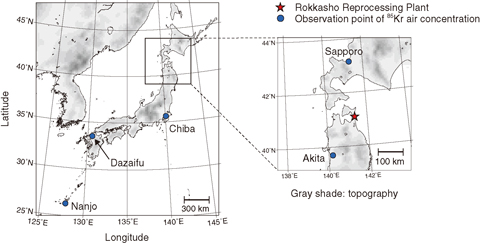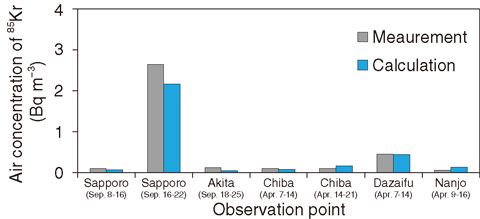
Fig.4-22 Calculation areas and observation points of air concentration of 85Kr

Fig.4-23 Simulation result of the air concentration of 85Kr by WSPEEDI-II
When radioactive materials are discharged into the atmosphere due to nuclear accidents, atmospheric dispersion simulations are very important for the understanding of the distributions of released radioactive materials and planning of environmental monitoring and countermeasures for the radiation protection of the public. Simulations are conducted over a wide-range of areas from the immediate vicinities of accident sites to regions far distant from them, depending on the magnitudes of the accidents. Then, model parameters that can appropriately simulate various phenomena depending on the scale of the objective area are important for precise simulations. Diffusive effects due to wind turbulence are typically expressed by diffusion coefficients in atmospheric dispersion models. The horizontal diffusion coefficient by Gifford (1982) (hereafter, GFD) is usually used for long-range dispersion with a horizontal distance of several thousand km. However, there have been few verification studies of GFD for middle-range scale dispersions over distances of several hundred km.
In this study, we verified the performance of the second Worldwide version of System for Prediction of Environmental Emergency Dose Information (WSPEEDI-II) for middle-range scale dispersion by dispersion analysis of krypton-85 (85Kr), which was released in test operations at the Rokkasho Reprocessing Plant (RRP) in Aomori Prefecture, Japan using GFD. Air concentrations of 85Kr were observed at several sites in Japan to understand the background level (Fig.4-22). The observation detected the 85Kr discharged from RRP at locations 200-2000 km away. Since 85Kr is a nonreactive gas with a half-life of 10.76 years and the release point is known, the observation data are particularly useful for the verification of diffusion processes.
WSPEEDI-II reproduced weekly mean surface air concentrations of 85Kr with errors ranging between 0.5 and 2 times as much as the measurements. However, from a sensitivity analysis of the horizontal grid distances (resolution) of the meteorological model ranging from 2 to 54 km (used for local- to global-scale simulations), it was found that as the simulated grid resolution became higher, the calculated concentrations became lower than the results using the 54 km resolution. It is believed that the concentrations around the distribution center were underestimated because diffusive effects explicitly represented by grid-resolved wind fields may have been considered redundantly by GFD when using meteorological fields with relatively high grid resolutions. On the basis of the sensitivity analysis, an empirical modification method for GFD according to the grid resolution was proposed. This method improved the reproducibility of concentrations in the middle-range scale, and the result showed the usefulness and validity of this method (Fig.4-23). Using the diffusion coefficients modified by this method, the problem of calculated concentrations varying depending on the selected grid-resolution was remedied, and dispersion simulations that are consistent from local- to global-scales became possible.